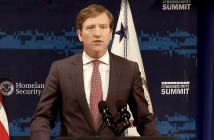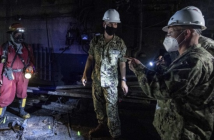Mike Sewart, the managing director of advanced services and products and the director of research, experimentation and innovation in QinetiQ, discusses partnering with the Ministry of Defence to drive innovation, open standards for future systems, investing in future capability and the nature of future military advantage with Defense & Aerospace Report Editor Vago Muradian at the DSEI 2019 conference and tradeshow in London. Our coverage is sponsored by L3Harris and Leonardo DRS and in partnership with Clarion Events — DSEI’s organizer — and working with the UK Department of International Trade’s Defence & Security Organisation to bring our audience the best in British defense.
Vago Muradian: Welcome to the Defense and Aerospace Report. I’m Vago Muradian here at the Excel Center in London covering this 20th anniversary edition of DSEI, one of the world’s leading defense and security shows. Our coverage here is sponsored by L3Harris and Leonardo DRS, and we’re also partnered with Clarion Events, the organizer of this great exhibition and many others around the world. And we’re working with the UK Department of International Trade, Defence and Security Organization to bring you the very best of British defense.
We’re here back again on the QinetiQ stand to talk to Mike Sewart who is the Director of Research and Development at this highly innovative company.
Mike, there was a great address yesterday by Sir Nick Carter, the Chief of Defence Staff; Stephen Lovegrove, the senior most civil servant in the Ministry of Defence talking about the importance of a partnership with industry to drive this innovative agenda. Anybody who knows Sir Nick knows he has arrayed service talent. Each one of the service chiefs have been hand-picked to be innovative, to drive change at this key time of uncertainty. At the same time each one of those service chiefs have sort of laid the conditions for successful innovation.
So let’s talk about the industry piece. You come from a technology background. You were at Fujitsu for a very, very long time. What’s the right way to make this happen? Because defense is very different from sort of a Silicon Valley, highly agile. Defense can be agile, but at the end of the day you have companies that have shareholders like yours. The Department is saying hey, we want you guys to innovate. On the other hand, you have a board to address. Right? So you’re no longer DARPA that can-do innovation for the sake of innovation.
What’s the right way for the Department to be thinking about how to do this to succeed if on the military side you have the right talent, you have innovative people in industry. How do you get that interface right?
Mike Sewart: I think it’s a great, great question, and I think it’s complicated because you’ve got the MoD ecosystem to consider and you’ve got the industry ecosystem to consider.
To start with MoD, I think the key thing there is really looking at what elements of MoD need to be doing what? You’ve got some great institutions like DSTL, and Gary Aitkenhead in his keynote speech yesterday was talking about the need for innovation and driving that into the S&T base. That’s really, really important.
I was talking myself with Claire Cameron this morning who’s heading up all of the defense innovation funds including DASA and DIU and understanding where they play as well. And then you’ve got the different line commands and the innovation cells within the front line commands.
So I think part one of solving this equation, to your question, is coordinating the innovation activity across the MoD ecosystem, because innovation for me is one percent ideas, 99 percent execution. If we follow the execution path properly, we get coordination. That allows industry then from our side to start engaging in a productive manner, rather than all different companies working with the front line commands attempting to try and move capability on. If we can coordinate it ourselves in a better way, partner more effectively, and genuinely across industry we need to get better at partnering, rather than doing everything ourselves. Coming together in a coordinated way with the MoD, we’ll start to actually join the whole thing up.
Muradian: And just for our audience, Defence Innovation Unit is the same as in the United States, it’s just here in the UK. And of course you’re talking about the legendary Defense Science and Technology Laboratory, which is an extraordinary organization, as you guys were.
Sewart: We were part of the same family together before, and we’ve got a great relationship with DSTL. A lot of the work that QinetiQ does is in coordination with DSTL. It’s a good partnership. It’s working really, really well for us.
Muradian: But for conditions of success to exist, one of the things everybody is talking about is the openness of architecture. But at the end of the day, Defense Contractors have been as successful as they are, some of them, by ensuring that some of their most important systems are actually remarkably closed.
Sewart: That’s right.
Muradian: So that there is a constant fee the customer has to pay at the end of the day to access or to keep that system refreshed. In certain cases systems have been open, but there’s almost always an asterisk somewhere around that. You [inaudible]have an open system because at the end of the day there are even things that QinetiQ profits from that is a franchise that you guys closely guard that is in some cases an important cash cow for the company.
So what’s the right way to get this balance right where your equities as companies that are answerable to shareholders, while at the same time opening these architectures and allowing the customer to have that flexibility so that at some point if it tires, for example, of QinetiQ it can go to somebody else or vice versa.
Sewart: I think if you rewind 15-20 years, you’ve got a lot of large-scale systems, large-scale platforms that actually necessitated a more vertical approach to solution construction.
If you look at now, the world has changed. You’ve got smaller assets. They are less expensive. There’s more of them. The pace of change is increasing. And more and more it’s important that this new capability can coexist with existing legacy capability.
So anyway, the environment has changed in such a way that you’re driving much more of a need for interoperability across legacy systems and new systems. So that’s lending itself to the front line commands and really screaming out for interoperability across systems. And it means that we as industry partners need to be pushing those open standards much more, working with MoD to set the policy, to drive the approach to incentivize industry. Because to be fair, there’s a lot of money to go around and I think everyone can actually profit in their own correct ways from the ecosystem, but we’ve got to learn to play together a lot better.
Muradian: How much of this is the investment that you have to put into this? Because the underlying message was hey, invest and bring us ideas. We heard that from DoD looking to contractors to do that. But part of the challenge was contractors saying well, hang on a second. If I build a better mousetrap all you’re going to do is compete it, so at the end of the day I’m not rewarded for having come up with a better mousetrap. I may be rewarded for coming up with a better mousetrap.
How much of this should be your investment? How much of this is better requirements control? How do you do this to make sure that the guidance you’re giving industry about the problems you want solved? Because it’s the age-old problem, right? If you come to the department and say hey, hold on a second. I really have a clever idea, they’re going to end up competing it and you lose that first mover advantage.
Sewart: That’s true, but I think there is work afoot now that is looking to resolve that. So we’ve created a lot of our leadership ourselves around what we call prototype warfare, and prototype warfare is all about really working with the end user to create minimum viable products, learning from the technology industry to say that you know what? It’s the old school way of thinking about requirements and a long monolithic approach of system design though it to capability generation. The last century, the new world, there’s more disposable assets, smaller assets and faster moving technology. We need to be prototyping a lot, lot more.
So if you look across the MOD, there’s now work afoot, like Information Warrior with the Navy; AWE18, that’s the program that was run by the Army last year. Some really good experiment-based events. And those experimental events allow industry to come together with products that they have put PV funding into themselves. We focus ourselves in QinetiQ on co-creation with our customers. They’re working with like data to match fund engagement. That allows everyone quite a bit of skin in the game. So QinetiQ invests, DASA invests, working with the front line commands to actually iterate that functionality. And you build that up quite quickly over time.
So if you look at the work that we’ve done recently with both DSTL, DASA and the Army on robotics and autonomous systems, we have really worked to create a program of work from the initial concept through to the creation of a platform, a land autonomous platform for logistics supply in two years. And that’s pretty quick for defense. Still slow, I feel, it’s gone a little bit slow, but ultimately we’re getting there and that’s because match funding allows organizations just to get a bit of clarity that we’re investing in an area where the government wants to go as well.
Muradian: And for the audience, DASA is?
Sewart: Defense Acceleration Security Accelerator.
Muradian: Because time is short, two Royal Australian Air Force Group captains, Lyle Holt and Jerome Reid gave a great presentation at the Day Zero Conference about Plan Jericho which is the Royal Australian Air Force’s sort of strategy to better defend Australia in a highly increasingly contested, faster moving technological world. And one of the points that Jerome made was that actually there’s no such thing as dominance. There is actually remarkably short advantage. Do you agree with that? That the idea of dominance is something that is unlikely given distribution and the proliferation of technology? And that the key will be, that advantage will be hopping around. And it’s he or she who can better harness that advantage at that moment is the key.
What’s the right way to think about this dynamic environment we’re in? Because it’s not like the Cold War. It’s not like China didn’t have access to the best educational systems in the West or access to the technology. I mean we’re in a completely different universe now, and everybody has access to the same technology.
Sewart: That’s right. I do completely subscribe to that thinking. I mean pace and agility are the key to capability generation now, and that’s about actually looking at how we can all execute faster. Like I said before, innovation is all about execution. First to market, you know, that is so, so critical. So we’ve got to think about all the operational processes, all the business processes, all the policies that fit within MoD and industry and how we can actually come together to actually move quicker. Because if we don’t, we’re in trouble.
Muradian: Mike Sewart, the Director of Research and Development at QinetiQ, one of the world’s most innovative companies.
Sir, thanks very much for joining us. I really appreciate it.
Sewart: Thank you very much.
30



